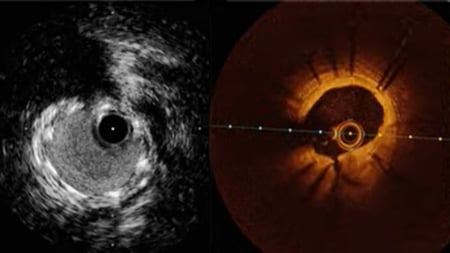Antithrombotic therapy after acute coronary syndrome or PCI in atrial fibrillation (the AUGUSTUS trial)
Selected in The New England Journal of Medicine by E.W. Holy , S. Brugaletta
References
Authors
Lopes RD, Heizer G, Aronson R, Vora AN1, Massaro T, Mehran R, Goodman SG, Windecker S, Darius H, Li J, Averkov O, Bahit MC, Berwanger O, Budaj A, Hijazi Z, Parkhomenko A, Sinnaeve P, Storey RF, Thiele H, Vinereanu D, Granger CB, Alexander JH; AUGUSTUS Investigators
Reference
N Engl J Med. 2019 Mar 17 [Epub ahead of print]
Published
March 2019
Link
Read the abstractReviewers
Our Comment
This joint review is part of the PCRonline GLOBAL Journal Club Initiative by selected members of the EAPCI/PCR Journal Club and PCR NextGen, and is based on the underlying idea of “Bringing peers together, exchanging ideas, towards a common standard of care”.
Why this study – the rationale/objective?
Dual antiplatelet therapy (DAPT) is the established standard of care following percutaneous coronary interventions (PCI). Nevertheless, in patients with non-valvular atrial fibrillation treated with oral anticoagulation (OAC) the optimal antithrombotic regimen after PCI remains unclear. Recent trials have suggested that a combination of an oral anticoagulant with a single antiplatelet agent may provide similar outcomes with regard to efficacy endpoints but an overall improvement in safety profile when compared to a triple antithrombotic (DAPT+OAC) regimen. AUGUSTUS was a prospective, multicenter two-by-two factorial, randomized clinical trial comparing for the first time apixaban vs. a vitamin K antagonist (VKA) and aspirin vs. placebo in patients with atrial fibrillation who had a recent acute coronary syndrome or underwent PCI (or both).
How was it executed – the methodology?
A total of 4,614 patients (median age, 70.7 years; 29% women, median CHAD2DS2-VASc score, 4; median HAS-BLED score, 3) with atrial fibrillation were enrolled and randomized within 14 days (mean, 6.6 days) of an ACS episode or coronary stent implantation to apixaban or VKA and to either aspirin or matching placebo for 6 months. All patients were required to be taking a P2Y12 inhibitor during the trial.
- The primary endpoint was major or clinically relevant non-major bleeding according to the International Society on Thrombosis and Haemostasis (ISTH) definition.
- Secondary endpoints included a composite of death or hospitalization and a composite of death or stroke, myocardial infarction, stent thrombosis or urgent revascularization.
What is the main result?
- The 6-month primary endpoint occurred significantly less among patients taking apixaban vs. VKA (10.5% vs. 14.7%, HR 0.69, 95% CI 0.58-0.81; p<0.001). This event rate was 16.1% with aspirin and 9% with placebo (HR 1.89, 95% CI 1.59-2.24; p<0.001). The highest bleeding rates were reported among patients treated with VKA and aspirin (18.7 %) and the lowest rates occurred among those taking clopidogrel, apixaban and placebo (7.3%).
- Patients in the apixaban group had a lower incidence of death or hospitalization than those in the vitamin K antagonist group (23.5% vs. 27.4%; HR 0.83; 95% CI, 0.74 to 0.93; P=0.002) and a similar incidence of ischemic events. Patients in the aspirin group had an incidence of death or hospitalization and of ischemic events that was similar to that in the placebo group.
Critical reading and the relevance for clinical practice
The AUGUSTUS trial demonstrates that the combination of apixaban and a P2Y12 inhibitor such as clopidogrel – without aspirin – is the safest treatment regimen for patients with atrial fibrillation undergoing PCI, resulting in less bleeding and fewer hospitalizations without significant differences in the incidence of ischemic events than a regimen that includes a vitamin K antagonist, aspirin, or both.
This trial adds important data to the growing body of evidence suggesting that it is safer to treat atrial fibrillation patients who underwent PCI with anticoagulation and a P2Y12 monotherapy rather than with a triple antithrombotic regimen. Overall these results are in line with previous reports from WOEST, PIONEER AF and RE-DUAL PCI and it is reassuring that the ischemic events did not differ significantly between the different treatment arms.
It should be noted, that there was no true aspirin naive condition, as all patients were on aspirin at the time of PCI and it remains to be established whether some patients should still receive aspirin at a very early stage after PCI.
Of note, a numerically high rate of ischemic events such as myocardial infarction as well as stent thrombosis was observed in the placebo group at 6 months. For the moment it remains unclear when these events occurred (early versus late). Furthermore, we miss data on the complexity of the PCI procedure (bifurcation lesions, left main lesions, CTO, etc). Hence, we cannot exclude that in patients undergoing complex PCI addition of aspirin on top of a (N)OAC and a P2Y12 inhibitor may still be advisable.
Clopidogrel was the P2Y12 inhibitor of choice (92.6%) and reliable data on the safety of more potent inhibitors such as prasugrel or ticagrelor in combination with OAC are still missing.
Finally, the low time in therapeutic range (TTR: in the low 50% range) reflects an under-dosing of VKA therapy which raises the question whether the results would have been less favourable for apixaban if a higher TTR would have been achieved. On the other hand, this effect in favour of VKA may have been counterbalanced anyway by an expected higher rate of bleeding events paralleling an increased TTR.
Do you have an antiplatelet/anticoagulant protocol in your institution for those patients with atrial fibrillation who undergo PCI?







No comments yet!